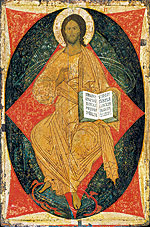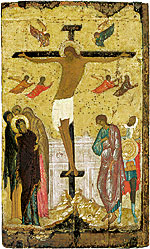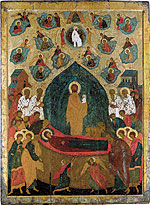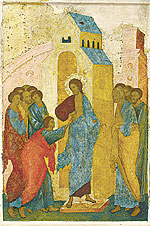 | ||
Dionisy’s Autographin the soffit of the northern portal. It describes the creation of the St. Ferapont Monastery frescoes (left side) Search | ||
 |
|
The St. Paul Obnorsk (Pavlo-Obnorsky) Monastery. The Trinity Cathedral. 1500
The monastery was founded by St. Paul of Obnorsk, a disciple of St. Sergius of Radonezh on the River Obnora not far from Vologda with the blessing of the Metropolitan of Moscow Photius in 1414. The following is known about the life and death of St. Paul of Obnorsk. Paul was born in Moscow in the first half of the 14th century. From childhood he craved to be a monk. Soon he joined the cloister of St. Sergius of Radonezh where he lived as a hermit for 15 years. An advocate of silent contemplation, he wanted yet more seclusion: he wanted to settle down in deserted Volga forests. He begged his teacher to bless his hermitage in the wilderness.
On parting, Sergius blessed Paul and gave him a cross that he treasured all his life.
The biography of the saint testifies that during his wanderings he happened to live in a hole of a huge linden tree for three years and to meet well-known hermits of the time Avramy Chukhlomsky and Sergius of Obnorsk (Nurmsky).
Paul’s life in primeval forests won him a fame of a great hermit and attracted coenobites driven by an aspiration to save their soul. Eventually, the elder (starets) resolved to give up his hermetic life and set up a cloister.
 The Saviour with Forces. Dionisy |
So on the site of Paul’s hermitage, the Trinity Cathedral and monastery were built. At the end of his life, Paul felt an urgent need for silent calm. Having appointed his disciple as head of the cloister, he settled down on the other side of the Nurma River. The saint died on 10 January 1429. In the second half of the 19th century, this land was bought by the monastery and two memorial chapels were built: one, on the spot of Paul’s cell, where he prayed and the other, over the well, dug by him.
In 1500, Dionisy painted the iconostasis for the wooden Trinity Cathedral.
A carved inscription on the back of the central Deesis icon The Saviour in His Might says that “in the year of 7008 (1500) the Deesis, the Feasts and the Prophets were painted by Dionisy”. In 1505-1516, by the decree of Vassily III the original wooden cathedral was replaced with a stone one and Dionisy’s iconostasis was moved there.
Most of the old icons of the Trinity Cathedral have not survived. Only 4 icons have been preserved: The Saviour in His Might; The Crucifixion of the Feasts tier (both are in the Tretyakov Gallery); St. Thomas’s Protestation of the Feasts tier (The Russian State Museum) and The Dormition of the Theotokos of the Sovereign tier (The Vologda State Museum of History, Architecture and Art).
Most probably, Dionisy’s assistants, his sons, took part in painting the iconostasis of the St. Paul Obnorsk Monastery, only the Crucifixion is the unquestionable work of the master himself.
 The Crucifixion. Dionisy |
The exceptional quality of the icon and a particular spiritual interpretation of the traditional subject confirm the attribution. The iconographic solution of the Crucifixion demonstrates that Dionisy was familiar not only with the artistic legacy of Andrei Rublev but also with theological ideas of his time.
The painter includes personified representations of the Old Testament and New Testament Churches which can be regarded as an echo of the late 15th century theological dispute with heretics over of the Church issue.
The main theme of the Crucifixion is the triumph of life over death. There is no suffering, only a prototype of the coming resurrection. The triumphant colour range is noble and elegant, the body proportions are elongated and the poses are graceful. The intensity of the theme is conveyed through an intricate rhythmical composition replete with repetitions and eloquent pauses.
In winter of 1529, Vassily III with his second wife Elena Glinskaya undertook a pilgrimage to the St. Cyril Belozero and adjacent monasteries trying to find a cure for childlessness. Soon after they visited St. Paul’s cloister, the construction of the second stone cathedral of the Dormition of the Mother of God started.
However, a few years later, in 1538, the Kazan Tatars that arrived from the south looted the monastery. This took place during the rule of Hegumen Protasy, the first author of the biography of St. Paul of Obnorsk. Nevertheless, thanks to the patronage of Moscow’s grand princes and tsars who favoured the northern monasteries and sent rich endowments there, the cloister managed to build several stone buildings and put the extensive monastery estate in order.
The stone Trinity Cathedral was erected in 1505-1516. Unfortunately, it has not survived and can be seen only in old drawings, photos and descriptions.
In 1545, a small church was built next to the southern wall of the Trinity Cathedral. Its upper floor houses the St. Sergius of Radonezh Side-chapel, whereas on the lower floor there is the St. Paul of Obnorsk Side-chapel. Undoubtedly, its construction was sped up by the all-Russian canonization of Paul of Obnorsk at the Church Synod in 1547. In Paul’s church there was the founder’s tomb in which was the cross Sergius of Radonezh blessed Paul with. In the refectory there was another relic, a piece of the linden tree Paul lived in. In the 18th century, Russian monasteries lived through difficult times. Under Peter the Great, monasteries’ privileges were considerably cut and the income was seized. For Paul’s monastery this situation was aggravated by a big fire in 1764. Only in 1777, the renovation of the damaged buildings was completed. Yet, over the subsequent one hundred years the monastery dragged out a miserable existence at meagre public expense.
The situation changed drastically when Joasaph Tikhonov (1861-1877) became the hegumen and focused all his efforts on the revival of the monastery. Although he inherited an empty treasury and semi-dilapidated buildings, he managed to collect from voluntary donors and spend two hundred thousand rubles on construction and other needs.
 The Dormition of the Theotokos. Dionisy |
Under Joasaph the road to the monastery was leveled and a guesthouse for wealthy pilgrims and an inn for their servants were built. The Nurma River that flowed too close to the monastery’s walls was diverted into a canal and the dry bed was used for kitchen gardens. The monastery was enclosed with a 3-metre high stone wall with three eight-sided towers and two gates. A cellar with brick vaults that survived intact was dug under the southern wall. The hegumen also made an arrangement for fir and pine groves to be planted on the high woodless bank of the Nurma. A hermitage (skete) in the name of Christ’s Resurrection was set up not far from the monastery.
The hegumen compiled a special charter notable for its strict piety. The monks were to live in constant labour and prayer and to eat only vegetarian food. Women were not allowed to enter the skete. In November 1877, a serious illness made Joasaph give up the abbacy. The construction in Paul’s monastery immediately stopped: the only major building built in the ‘post-joasaphian’ period was a bell tower.
At the beginning of the 20th century, in 1904, a school of icon painting for twenty pupils was arranged in the hegumen’s building. In 1908, construction of a new guesthouse began. This spacious and modest-looking building exists today. In summer 1909, the monastery suffered a terrible fire that ruined Paul Obnorsky’s silver shrine set up by Joasaph.
Donations for the cloister’s reconstruction were collected throughout Russia. Tsar Nicholas II donated a new shrine for the saint’s relics. In summer 1912, the reconstruction works were completed. This event was marked by a visit of the sister of Empress Alexandra Fedorovna, Grand Duchess Elizaveta Fedorovna.
In 1924, the cloister was closed down and the Trinity Cathedral, belfry and monastery walls were destroyed.
Only 70 years later, in 1994, the monastery witnessed prayers and praise to God again. The monastery that used to have a stavropigial status and the Saviour Transfiguration, Makary Pisemsky, Saint Annunciation and Innokenty Komelsky monasteries under it, is now a town church of the Vologda Saint Priluki Demetrius Monastery. On June 5 1999, the Dormition Refectory Cathedral was consecrated.
Experts know of around ten cathedrals whose walls were painted by Dionisy. Some of the painter’s works are lost for good; some have been preserved by restorers
Only the wall painting of the Virgin Nativity Cathedral of the St. Ferapont Belozero Monastery has survived in full and intact |
|
According to historical documents, the following works of Dionisy (the dates indicate the year of their painting) are known:
 St. Thomas’s Protestation. Dionisy and his studio |
See also:Dionisy’s sons Theodosius and Vladimir |
|
|
 |
SUPPORTING WITH:
| |||||||||||||








